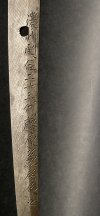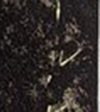- Joined
- Sep 8, 2023
- Messages
- 5
Greetings and salutations! I hope everyone is having a wonderful day!
I have a WWII Japanese sword that I traded my uncle a knee board for the sword when I was a kid. He found it in a house he purchased in Key West. It was above the door frame inside a closet.
I apologize for not knowing the correct terms. I did some Internet research and the information was all over the place. It was hard to separate truth from fiction. The sword is pretty rusty on the outside, the blade itself isn't too bad. It has a metal sheath/ scabbard that has some brown paint on it that could be original. The hilt appears to be shark/ manta ray skin wrapped with a cloth strap. The scabbard has a single ring. The hilt is rounded with a tassel hole in it. I think someone added a screw to the tang hole closest to the blade. The tang has two holes. the bamboo pin in the back hole is broken in half with one half still stuck in the hilt. The blade itself has little rust on it and is coated in what looks, smells, and feels like really old axle grease. Possibly someone coated it in axle grease to try to prevent it from rusting. There are what appears to be Japanese characters on both sides of the tang. I couldn't make them out due to the rust build up. The sword has a safety release to lock it in the scabbard, however the catch is broken and the button is seized up. There are some nicks in the blade.
I would like to clean it up a little and didn't want to damage the sword any further than it already is by doing it incorrectly. Any advice on how to clean the sword would be greatly appreciated. If anyone has any further information about what type this sword is or how to identify if it is factory made, handmade, or possibly a blade that had the hilt altered for WWII purposes.
Sword Photos:
Thank you kindly!
Carp
I have a WWII Japanese sword that I traded my uncle a knee board for the sword when I was a kid. He found it in a house he purchased in Key West. It was above the door frame inside a closet.
I apologize for not knowing the correct terms. I did some Internet research and the information was all over the place. It was hard to separate truth from fiction. The sword is pretty rusty on the outside, the blade itself isn't too bad. It has a metal sheath/ scabbard that has some brown paint on it that could be original. The hilt appears to be shark/ manta ray skin wrapped with a cloth strap. The scabbard has a single ring. The hilt is rounded with a tassel hole in it. I think someone added a screw to the tang hole closest to the blade. The tang has two holes. the bamboo pin in the back hole is broken in half with one half still stuck in the hilt. The blade itself has little rust on it and is coated in what looks, smells, and feels like really old axle grease. Possibly someone coated it in axle grease to try to prevent it from rusting. There are what appears to be Japanese characters on both sides of the tang. I couldn't make them out due to the rust build up. The sword has a safety release to lock it in the scabbard, however the catch is broken and the button is seized up. There are some nicks in the blade.
I would like to clean it up a little and didn't want to damage the sword any further than it already is by doing it incorrectly. Any advice on how to clean the sword would be greatly appreciated. If anyone has any further information about what type this sword is or how to identify if it is factory made, handmade, or possibly a blade that had the hilt altered for WWII purposes.
Sword Photos:
Thank you kindly!
Carp
Last edited:




